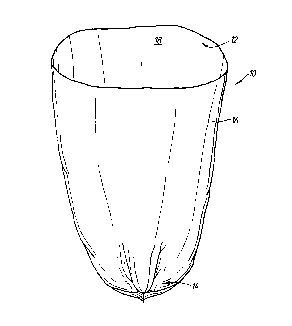Some of the information on this Web page has been provided by external sources. The Government of Canada is not responsible for the accuracy, reliability or currency of the information supplied by external sources. Users wishing to rely upon this information should consult directly with the source of the information. Content provided by external sources is not subject to official languages, privacy and accessibility requirements.
Any discrepancies in the text and image of the Claims and Abstract are due to differing posting times. Text of the Claims and Abstract are posted:
| (12) Patent: | (11) CA 2071062 |
|---|---|
| (54) English Title: | TRASH CAN LINER |
| (54) French Title: | GARNITURE INTERIEURE DE CONTENANT A ORDURES |
| Status: | Expired and beyond the Period of Reversal |
| (51) International Patent Classification (IPC): |
|
|---|---|
| (72) Inventors : |
|
| (73) Owners : |
|
| (71) Applicants : |
|
| (74) Agent: | GOWLING WLG (CANADA) LLP |
| (74) Associate agent: | |
| (45) Issued: | 1999-11-16 |
| (22) Filed Date: | 1992-06-11 |
| (41) Open to Public Inspection: | 1992-12-18 |
| Examination requested: | 1997-03-13 |
| Availability of licence: | N/A |
| Dedicated to the Public: | N/A |
| (25) Language of filing: | English |
| Patent Cooperation Treaty (PCT): | No |
|---|
| (30) Application Priority Data: | ||||||
|---|---|---|---|---|---|---|
|
A trash can liner is disclosed which evenly distributes the load
across the sealed bottom portion thereof. The liner includes a body
portion which is formed from a tube of coextruded, thermoplastic film.
The tube includes edge portions which are folded inwardly towards the
center line of the tube along first and second fold lines. The tube
is also folded along its center line prior to sealing to form a
construction including eight overlapping walls of approximately equal
width. A pair of heat seals extend through each of the eight
overlapping walls at one end of the tube, the heat seals being
separated by an unsealed area.
Note: Claims are shown in the official language in which they were submitted.
Note: Descriptions are shown in the official language in which they were submitted.

2024-08-01:As part of the Next Generation Patents (NGP) transition, the Canadian Patents Database (CPD) now contains a more detailed Event History, which replicates the Event Log of our new back-office solution.
Please note that "Inactive:" events refers to events no longer in use in our new back-office solution.
For a clearer understanding of the status of the application/patent presented on this page, the site Disclaimer , as well as the definitions for Patent , Event History , Maintenance Fee and Payment History should be consulted.
| Description | Date |
|---|---|
| Inactive: IPC from MCD | 2006-03-11 |
| Inactive: IPC from MCD | 2006-03-11 |
| Time Limit for Reversal Expired | 2002-06-11 |
| Letter Sent | 2001-06-11 |
| Grant by Issuance | 1999-11-16 |
| Inactive: Cover page published | 1999-11-15 |
| Inactive: Final fee received | 1999-08-18 |
| Pre-grant | 1999-08-18 |
| Letter Sent | 1999-06-01 |
| Notice of Allowance is Issued | 1999-06-01 |
| Notice of Allowance is Issued | 1999-06-01 |
| Inactive: Approved for allowance (AFA) | 1999-05-10 |
| Inactive: Status info is complete as of Log entry date | 1998-07-20 |
| Inactive: Application prosecuted on TS as of Log entry date | 1998-07-20 |
| Inactive: Multiple transfers | 1998-02-23 |
| Request for Examination Requirements Determined Compliant | 1997-03-13 |
| All Requirements for Examination Determined Compliant | 1997-03-13 |
| Application Published (Open to Public Inspection) | 1992-12-18 |
There is no abandonment history.
The last payment was received on 1999-05-18
Note : If the full payment has not been received on or before the date indicated, a further fee may be required which may be one of the following
Patent fees are adjusted on the 1st of January every year. The amounts above are the current amounts if received by December 31 of the current year.
Please refer to the CIPO
Patent Fees
web page to see all current fee amounts.
| Fee Type | Anniversary Year | Due Date | Paid Date |
|---|---|---|---|
| Request for examination - standard | 1997-03-13 | ||
| MF (application, 5th anniv.) - standard | 05 | 1997-06-11 | 1997-06-11 |
| Registration of a document | 1998-02-23 | ||
| MF (application, 6th anniv.) - standard | 06 | 1998-06-11 | 1998-05-15 |
| MF (application, 7th anniv.) - standard | 07 | 1999-06-11 | 1999-05-18 |
| Final fee - standard | 1999-08-18 | ||
| MF (patent, 8th anniv.) - standard | 2000-06-12 | 2000-05-18 |
Note: Records showing the ownership history in alphabetical order.
| Current Owners on Record |
|---|
| TENNECO PACKAGING INC. |
| Past Owners on Record |
|---|
| SCOTT THEODOR FREEMAN |